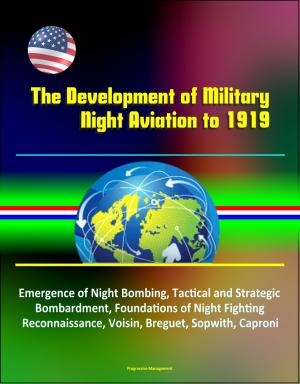Is the Army Developing Strategic Leaders? Case Studies of General George Marshall, William Westmoreland, and Eric Shinseki, World-class Warriors, Army Doctrine, Laws and Officer Grade Limitation Act
Nonfiction, History, Military, Strategy, United States| Author: | Progressive Management | ISBN: | 9781370555123 |
| Publisher: | Progressive Management | Publication: | January 24, 2017 |
| Imprint: | Smashwords Edition | Language: | English |
| Author: | Progressive Management |
| ISBN: | 9781370555123 |
| Publisher: | Progressive Management |
| Publication: | January 24, 2017 |
| Imprint: | Smashwords Edition |
| Language: | English |
This excellent report has been professionally converted for accurate flowing-text e-book format reproduction. Given today's strategic environment and the demand put on the officer corps at every level, is the Army currently developing strategic leaders? The US Army doctrine and the Strategic Studies Institute (SSI) provide a definition and list of competencies that outlines what a strategic leader should possess. With that definition and list of competencies, the researcher will examine three military leaders, showing linkage to doctrine, which will illustrate examples of this doctrinal definition. Once this is established the research will illustrate the evolution over the last 70 years of the Officer Personnel Management System, through laws passed by Congress that set policy for the Army to arrive at its current system. The research showed that the current Officer Personnel Management System prepares officers to be strategic leaders.
CHAPTER 1 - INTRODUCTION * Background * The Issue * The Problem * The Purpose * Research Questions * Primary Research Question * Secondary Research Questions * Assumptions * Key Terms * Limitations * Scope * Delimitations * Significance of Research * Summary and Conclusions * CHAPTER 2 - LITERATURE REVIEW * What is a Strategic Leader? * Strategic Leader Business World * Harvard Business School * Brian Tracy International * A Snapshot of the Strategic Leader * Four Timeless Qualities of Strategic Leaders * Army Doctrine Reference Publication 6-22 * Strategic Leadership Competencies * Introduction to Case Studies * General George Marshall * General William Childs Westmoreland * General Eric K. Shinseki * Congressional Laws and the Officer Personnel Management System * Congressional Law * The Officer Grade Limitation Act of 1954 * The Defense Officer Personnel Management Act of 1980 * Department of the Army Pamphlet 600-3 * CHAPTER 3 - INTRODUCTION * Research Methodology * Data Processing and Analysis * Defining and Analyzing Strategic Leadership * Ethics Consideration * Validity * Summary and Conclusion * CHAPTER 4 - ANALYSIS * Introduction * Primary Research Question * Is the Army currently developing strategic leaders? * Secondary Research Question * What is a strategic leader? * Identity * Mental Agility * Cross-cultural Savvy * Interpersonal Maturity * World-class Warrior * Professional Astuteness * The Officer Personnel Management System * CHAPTER 5 - CONCLUSIONS AND RECOMMENDATIONS * Introduction * Findings * Unexpected Findings * Summary
The problem with the current officer career timeline is it constrains an officer by limiting time to broaden oneself. Broadening is a strategic goal of the current CSA. A broadening assignment for an officer is an assignment outside the traditional tactical assignments which must be completed before their promotion board.6 The current 20 year officer timeline pushes for tactical assignments and if time allows, an officer can have a broadening assignment. Because of the fixed timeline an officer must complete certain assignments before their promotion board to be considered for the next rank. Without completing the required 24 month key development time (tactical assignment prescribed in DA Pam 600-3 his or her branch, an officer would not be considered for the next rank. For example, a Major leaving the Command and General Staff College (CGSC) generally has five years before his or her Lieutenant Colonel board. The time constraint before this board can limit the opportunity for an officer to broaden themselves outside the normal tactical assignments. Majors must have successful evaluations in their key development (KD) jobs and others to be competitive to be promoted to the next rank.
This excellent report has been professionally converted for accurate flowing-text e-book format reproduction. Given today's strategic environment and the demand put on the officer corps at every level, is the Army currently developing strategic leaders? The US Army doctrine and the Strategic Studies Institute (SSI) provide a definition and list of competencies that outlines what a strategic leader should possess. With that definition and list of competencies, the researcher will examine three military leaders, showing linkage to doctrine, which will illustrate examples of this doctrinal definition. Once this is established the research will illustrate the evolution over the last 70 years of the Officer Personnel Management System, through laws passed by Congress that set policy for the Army to arrive at its current system. The research showed that the current Officer Personnel Management System prepares officers to be strategic leaders.
CHAPTER 1 - INTRODUCTION * Background * The Issue * The Problem * The Purpose * Research Questions * Primary Research Question * Secondary Research Questions * Assumptions * Key Terms * Limitations * Scope * Delimitations * Significance of Research * Summary and Conclusions * CHAPTER 2 - LITERATURE REVIEW * What is a Strategic Leader? * Strategic Leader Business World * Harvard Business School * Brian Tracy International * A Snapshot of the Strategic Leader * Four Timeless Qualities of Strategic Leaders * Army Doctrine Reference Publication 6-22 * Strategic Leadership Competencies * Introduction to Case Studies * General George Marshall * General William Childs Westmoreland * General Eric K. Shinseki * Congressional Laws and the Officer Personnel Management System * Congressional Law * The Officer Grade Limitation Act of 1954 * The Defense Officer Personnel Management Act of 1980 * Department of the Army Pamphlet 600-3 * CHAPTER 3 - INTRODUCTION * Research Methodology * Data Processing and Analysis * Defining and Analyzing Strategic Leadership * Ethics Consideration * Validity * Summary and Conclusion * CHAPTER 4 - ANALYSIS * Introduction * Primary Research Question * Is the Army currently developing strategic leaders? * Secondary Research Question * What is a strategic leader? * Identity * Mental Agility * Cross-cultural Savvy * Interpersonal Maturity * World-class Warrior * Professional Astuteness * The Officer Personnel Management System * CHAPTER 5 - CONCLUSIONS AND RECOMMENDATIONS * Introduction * Findings * Unexpected Findings * Summary
The problem with the current officer career timeline is it constrains an officer by limiting time to broaden oneself. Broadening is a strategic goal of the current CSA. A broadening assignment for an officer is an assignment outside the traditional tactical assignments which must be completed before their promotion board.6 The current 20 year officer timeline pushes for tactical assignments and if time allows, an officer can have a broadening assignment. Because of the fixed timeline an officer must complete certain assignments before their promotion board to be considered for the next rank. Without completing the required 24 month key development time (tactical assignment prescribed in DA Pam 600-3 his or her branch, an officer would not be considered for the next rank. For example, a Major leaving the Command and General Staff College (CGSC) generally has five years before his or her Lieutenant Colonel board. The time constraint before this board can limit the opportunity for an officer to broaden themselves outside the normal tactical assignments. Majors must have successful evaluations in their key development (KD) jobs and others to be competitive to be promoted to the next rank.















